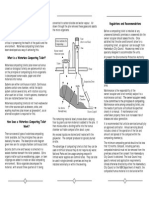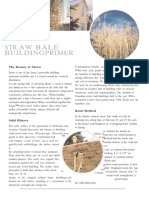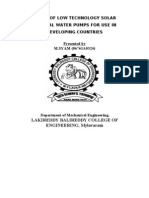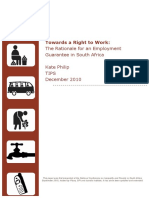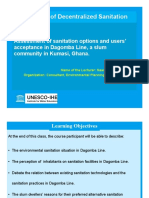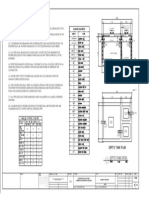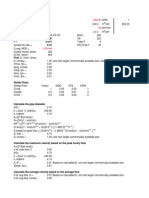2 GTZ Datasheet On Composting Toilets (2006)
2 GTZ Datasheet On Composting Toilets (2006)
Uploaded by
EddiemtongaCopyright:
Available Formats
2 GTZ Datasheet On Composting Toilets (2006)
2 GTZ Datasheet On Composting Toilets (2006)
Uploaded by
EddiemtongaOriginal Description:
Original Title
Copyright
Available Formats
Share this document
Did you find this document useful?
Is this content inappropriate?
Copyright:
Available Formats
2 GTZ Datasheet On Composting Toilets (2006)
2 GTZ Datasheet On Composting Toilets (2006)
Uploaded by
EddiemtongaCopyright:
Available Formats
technical data sheets for ecosan components
ecosan program - Deutsche Gesellschaft fr Technische Zusammenarbeit (GTZ) GmbH
03 Composting Toilets
SOLID
BIOWASTE FAECES
General Description
Waterless toilet systems
Receive mainly faeces, but treatment of urine and
solid biowaste is possible as well
GREY
WATER
RAIN
WATER
COLLECTION
Dry organic bulking material should be added
Produce a valuable soil conditioner with low pathogen
content
Suitable for both industrial and developing countries
URINE
TREATMENT
UTILIZATION
General description
A
General Description
Detailed information on different
types of Composting Toilets
B.1
B.2
B.3
B.4
A.1
Single-vault composting toilets
Multiple-vault composting
toilets
Movable bucket / bin
composting toilets
Composting toilets with mixing
devices
conditions since their water content and
the nitrogen content are too high.
Therefore an additive or so-called
bulking agent is recommended to lower
the water content, to improve aeration
and to increase the carbon content of
the material. Wood, chips, bark chips,
sawdust, paper and other substances
are commonly used.
Manufacturers and commercially
available composting toilets
Basic principles
The basic principle of a composting
toilet
system
is
the
biological
degradation of excreta and toilet paper
in a specially designed container. Urine
is usually collected separately, or in
some types of composting toilets
collected and treated together with
faeces. Organic food waste can be
added too.
Box 1: Optimum conditions for
thermophilic composting, allowing
temperature to rise up to 5070C:
Good aeration
Moisture content 50-60%
C/N ratio 30-35
Note that optimum conditions are
rarely achieved in composting toilets.
The decomposition process is called
composting, which is the degradation
of organic matter by thermophilic
aerobic bacteria and other micro
organisms. These bacteria rely on a
good aeration of the material, on
optimal moisture content and a specific
carbon to nitrogen ratio.
Figure 1: Schematic
of
continuous
composting toilet (Davison, 2001)
Since good aeration is very important,
the container is usually equipped with a
ventilation system that improves
aeration of the material and provides
odour control. Moreover, with bulking
agents, the pore spaces of the
composting pile can be increased;
hence it will be less compact, leading to
better aeration. However, too much air
flow can remove too much heat and
moisture, therefore the condition within
the composter should not be too cool or
dry.
Another benefit of adding bulking
materials is to increase C/N ratio in
order to attain the optimum composting
condition. Sometimes these bulking
materials also have an additional effect
on odour control by binding the
substances causing bad odours.
One main effect of the decomposition
process in a composting toilet is the
considerable volume reduction (10-30%
of the original mass), thus allowing the
prolonged storage of waste in the
container. The emptying frequency
depends on the size of the container,
the feeding rate and the composting
rate (volume reduction).
The decomposition process in a
composting toilet is rarely a real
thermophilic
composting
with
temperature rising above 50C, which
would guarantee complete pathogen
destruction and hygienization of the
waste. The pathogen content is reduced
considerably in a composting toilet.
However,
complete
pathogen
destruction can only be achieved if
good process conditions can be
guaranteed, e.g. by using an advanced
toilet design with insulation for
maintaining a high temperature within
the whole composting chamber.
The end product of a composting toilet
is an odourless stabilized material,
which is very valuable as soil
conditioner. It can be used directly for
non-food plants or for agriculture use.
Further treatment for hygienization such
as additional heap-composting or
prolonged storage (see box 2)
increases hygienic safety of agicultural
use.
A.2
Available technologies
Although there are many different
composting toilet designs that continue
to evolve, the basic concept of
composting remains the same.
Human excreta and food waste alone
do not provide those optimum
11/10/2006
version for discussion: please send your comments to ecosan@gtz.de
Page 1/3
technical data sheets for ecosan components
ecosan program - Deutsche Gesellschaft fr Technische Zusammenarbeit (GTZ) GmbH
A composting toilet has two basic
elements: a place to sit (or to squat) and
a composting chamber. Apart from
those basic elements, a ventilation
system is highly recommended in order
to stimulate aeration and prevent odour.
Available systems can be distinguished
is as follows:
Toilet seat and composting container
in the same unit, or separate
Some composting toilet systems have
the seat and the composting container
spatially separate, e.g. the toilet seat is
in the ground floor and the container is
situated below in the basement,
connected by a vertical tube. Other
systems have the toilet seat in the same
unit with the container. In that case,
containers are usually smaller and have
to be emtied more often.
Urine diversion or not
The toilet can be designed either with
or without urine diversion.
Detailed information on urine diversion
can be found in the GTZ technical data
sheet for urine diversion (01) on
http://www.gtz.de/en/themen/umweltinfrastruktur/wasser/9397.htm
It should be noted that without urine
diversion, more bulking agent needs to
be added in order to significantly lower
moisture level and increase C:N ratio to
attain the optimum treatment conditions.
Urine adds more water than is
necessary and it has a very high
nitrogen content. The moisture content
of faeces without urine (66-80%), plus
the addition of toilet paper and bulking
material are sufficient for good
processing.
Many composting toilets also have a
drainage system to allow evacuation of
liquids. These liquids are called
leachate
and
have
very
high
concentrations of nutrients, organics
and also contain pathogens. Leachate
needs to be collected, treated and
reused if possible. Urine diversion
usually allows to avoid or to
considerably
reduce
leachate
production.
Self-constructed
procured
or
commercially
There are many designs and models
offered by manufacturers all over the
world with a large range of prices.
However composting toilets can also be
self-constructed. Manufactured toilets
are often more expensive than selfconstructed systems.
11/10/2006
Box 2:
Suggested alternative recommendations for primary treatment of dry faeces
before use at household level. No addition of new material. (Schnning and
Stenstrm, 2004)
Treatment
Storage (only
treatment) at ambient
temperature 2-20C
Criteria
1,5-2 years
Storage (only
treatment) at 20-35C
Storage and alkaline
treatment
>1 year
pH >9 during
> 6 months
Low-tech or high-tech
The systems range from low-tech
(simple, non-electric, but more care is
required) to high-tech (complex, electric,
very low labour work, but higher cost)
systems. Low-tech composters are
simple reactors in which all is collected
and allowed to decompose in at
ambient temperature. They require the
user to take a more active role in the
day-to-day maintenance of the unit.
High-tech units can be equipped with
electric fans, automatic mixers and
thermostatically controlled heaters and
require very low level of user
intervention.
Single-vault (continuous) or multiplevault (batch)
Either multiple chambers batch composting, e.g. EcoTech Carousel, or single chamber continuous composting
process shown in figure 1, e.g. Clivus
multrum, Clivus minimus, BioLet, etc.
are feasible to use.
On-site or off-site composting
Most composting toilets process the
material on-site in a composting chamber that is located directly under in the
toilet seat or in the basement of the
building. Other systems however use
movable collection bins or containers
that are emptied frequently and where
the material is then transported to an
external site for treatment.
A.3
Applicability
Comment
Will eliminate most bacterial pathogens,
substantially reduce viruses, protozoa
and parasites, some soil-b ova may
persist
As above
Temperature <35, moisture content
>25 or lower pH will prolong the time
for absolute elimination
With proper management the toilet is
easy to use and to maintain, and the
final product is a high-quality compost
soil
conditioner
for
garden
or
agriculture.
Compared to dehydration toilets,
composting toilets require higher costs
in term of excreta management. The
most important difference between this
technology and that of dehydration is
the moisture content of faeces within
the vault (around 50% comparing to
25% in dehydration toilet). Composting
toilets need organic bulking materials to
increase carbon content whereas
dehydration toilet can use also other dry
absorbents as ash or dry soil to lower
the moisture content. The nutrients in
products from composting toilet are
more readily available to plants than
those from dehydration toilet.
Compared
to
VIP/pit
latrines,
composting toilets can be built above
ground level as permanent structure.
There is no need for digging deep pit
and periodical replacement of the facility
when pits are full.
Composting toilets are sealed systems
that exclude
any
infiltration of
contaminated
liquids
into
the
groundwater or other harmful emissions
into the environment.
Composting toilets can close the
nutrient cycle, turning a dangerous
waste product into safe compost,
without smell, hassle, or fly problems.
Composting toilets eliminate the need
for flushing water. No water supply (no
expensive installation for infrastructure
like water supply line and sewerage) is
necessary. Furthermore, it allows for the
recycling of valuable plant nutrients via
compost products.
They are usually less expensive than
conventional septic systems or sewered
systems (if costs for sewerage and
wastewater treatment are considered)
treatment and they will reduce
household total water consumption by
at least 25%.
This technology is suitable for both
industrialized and developing countries,
especially in arid regions and regions
without piped water or sewers. It works
without
water
and
wastewater
connection.
In several projects composting toilets
have
also
been
successfully
implemented in houses with several
floors.
In term of operation and maintenance,
composting toilets are most suitable
version for discussion: please send your comments to ecosan@gtz.de
Page 2/3
technical data sheets for ecosan components
ecosan program - Deutsche Gesellschaft fr Technische Zusammenarbeit (GTZ) GmbH
when users are committed to operate
the system carefully. Composting toilets
need more care than dehydration toilets
in the case of low-tech systems.
A.4
Further reading
Esrey, St. A., et. al., 1998, Ecological
sanitation. Department for Natural
Resources and the Environment, Sida,
Stockholm, Sweden.: Well-illustrated
book concerning different types of
composting
toilet
as
well
as
performance and health issues.
sources and the Environment, Sida,
Stockholm, Sweden.
Montgomery, T., 1990, On-Site wastewater treatment systems, Technical Bulletin No. 6, The New Alchemy Institute.
Peasey, A., 2000, Health aspects of dry
sanitation with waste reuse. Task No.
324, WELL.
Reed, B. and Shaw, R. Using human
waste, technical brief no. 63, WELL.
Del Porto, D. and Steinfeld, C., 2000,
The composting toilet system book. The
Center for Ecological Pollution Prevenst
tion (CEPP), 1 ed. with additions.: information on several types of composting toilet system, including practical application and maintenance.
Jenkins, Joseph, 2005, The Humanure
handbook a guide to composting human manure, Joseph Jenkins Inc,
Grove City, USA.
lain, Christophe, 2005, Un petit coin
pour soulage la plante Toilettes sches et histoires deau, ditions Goutte
de Sable, Athe, France.
A.5
References
Crennan, L., waterless toilets, Home,
Technical Manual: design for lifestyle
and the future, www.greenhouse.gov.au
Davison, L. and Schwizer, B., 2001,
Waterless composting toilets, septic
safe, Environment & Health Protection
Guidelines: On-site Sewage Management for Single Households.
Esrey, St. A., et. al., 1998, Ecological
sanitation. Department for Natural Re-
2006, GTZ
technical data sheets for ecosan
components
authors: GTZ ecosan team (Christine
Werner, Nathasith Chiarawatchai,
Florian Klingel, Patrick Bracken)
Deutsche Gesellschaft fr Technische
Zusammenarbeit (GTZ) GmbH
ecosan program
Dag-Hammarskjld-Weg 1-5
65760 Eschborn, Germany
T +49 6196 79-4220
F +49 6196 79-7458
E ecosan@gtz.de
I www.gtz.de/ecosan
11/10/2006
version for discussion: please send your comments to ecosan@gtz.de
Page 3/3
You might also like
- BS en 12255-8 2001 Waste Water Treatment PlantsDocument20 pagesBS en 12255-8 2001 Waste Water Treatment PlantsAbey VettoorNo ratings yet
- Compost Toilet InstuctionsDocument2 pagesCompost Toilet Instuctionsfgaspar4uNo ratings yet
- Waterless Composting Toilets Regulations and RecommendationsDocument2 pagesWaterless Composting Toilets Regulations and RecommendationsAdewale Adefemi JonathanNo ratings yet
- Good Stoves Facilitation: How to Innovate and Change the WorldFrom EverandGood Stoves Facilitation: How to Innovate and Change the WorldNo ratings yet
- Ecological ToiletsDocument143 pagesEcological ToiletsVerna03No ratings yet
- Storage Battery System For Solar Home Lightings and Mini-Grid System - Purely Off-Grid Installations - Zakir HossainDocument14 pagesStorage Battery System For Solar Home Lightings and Mini-Grid System - Purely Off-Grid Installations - Zakir HossainEnergy for AllNo ratings yet
- GreenHouses All RequierementsDocument64 pagesGreenHouses All RequierementsMarcos AntonioNo ratings yet
- Terry Mohn - Mini Grid Systems Standards and RegulationsDocument11 pagesTerry Mohn - Mini Grid Systems Standards and RegulationsAsia Clean Energy ForumNo ratings yet
- PMKSY - Micro Irrigation Drip System in Paddy By: Tmt. J.Vijaya Rani I.A.S Additional Director of Agriculture (PM)Document14 pagesPMKSY - Micro Irrigation Drip System in Paddy By: Tmt. J.Vijaya Rani I.A.S Additional Director of Agriculture (PM)ramoo.csaNo ratings yet
- The Ultimate Wood StoveDocument34 pagesThe Ultimate Wood StoveUmbisa Moses GwehonaNo ratings yet
- CompostingDocument12 pagesCompostingManthan KirdatNo ratings yet
- WWW - Ubakus.de: Roof For Passive HouseDocument4 pagesWWW - Ubakus.de: Roof For Passive HouseacmcNo ratings yet
- The World's First Passive HouseDocument15 pagesThe World's First Passive HouseMalavika AnandNo ratings yet
- Isku CatalogueDocument28 pagesIsku CatalogueIDrHotdogNo ratings yet
- Forced Ventilation & Fogging For GreenhouseDocument11 pagesForced Ventilation & Fogging For GreenhousePEPI SERPONGNo ratings yet
- How To Work Out The Passive House Form Factor - HEAT, SPACE AND LIGHT LTDDocument10 pagesHow To Work Out The Passive House Form Factor - HEAT, SPACE AND LIGHT LTDchiomaNo ratings yet
- Ultimate Rainwater Harvesting - Timothy R ClaytonDocument52 pagesUltimate Rainwater Harvesting - Timothy R Claytonkantorzf05No ratings yet
- Sustainable ArchitectureDocument34 pagesSustainable ArchitectureCaiuby Menezes da CostaNo ratings yet
- Water Less ToiletsDocument4 pagesWater Less ToiletsAfzal TamboliNo ratings yet
- Clivusmultrum Composting Toilets BookletDocument16 pagesClivusmultrum Composting Toilets BookletGreen Action Sustainable Technology GroupNo ratings yet
- Natura Green Wall: Brief Note On The System, Functioning and PeripheriesDocument15 pagesNatura Green Wall: Brief Note On The System, Functioning and PeripheriesRehanNo ratings yet
- 1 Vegetated Swale Technical GuidanceDocument4 pages1 Vegetated Swale Technical GuidanceAnkit KodinariyaNo ratings yet
- Rainwater Cisterns - Texas HandbookDocument88 pagesRainwater Cisterns - Texas HandbookSurvivItNo ratings yet
- Compot ToiltDocument7 pagesCompot ToiltRadha DamodarNo ratings yet
- FoundationsDocument4 pagesFoundationsfranbourkeNo ratings yet
- Geodome LSNDocument3 pagesGeodome LSNVidican Laura FlorinNo ratings yet
- Agri Plas GreenhouseDocument6 pagesAgri Plas GreenhouseBendzGeronaNo ratings yet
- New Zealand: The Economics of Zero Energy BuildingDocument52 pagesNew Zealand: The Economics of Zero Energy BuildingwarrenNo ratings yet
- Soil As A ResourceDocument32 pagesSoil As A Resourcehoabeo1984No ratings yet
- Passive TechniquesDocument22 pagesPassive TechniquesArnizya noushadNo ratings yet
- Architecture NZ - #6 November December 2021Document144 pagesArchitecture NZ - #6 November December 2021林VincentNo ratings yet
- Passive Annual Heat Storage Principles in Earth Sheltered HousinDocument6 pagesPassive Annual Heat Storage Principles in Earth Sheltered HousinpterodaktilNo ratings yet
- Civil Rainwater HarvestingDocument19 pagesCivil Rainwater HarvestingBabaji SharmaNo ratings yet
- 5bu 1 Plumbing Sanitary Pt5Document66 pages5bu 1 Plumbing Sanitary Pt5URIELA GAÑONo ratings yet
- 12-Direct Solar GainDocument3 pages12-Direct Solar GainaomareltayebNo ratings yet
- Conservation AgricultureDocument70 pagesConservation Agriculturechitrasharma28121999100% (1)
- Hand-Sculpted Homes: A Naturally Built Kitchen For A Children's Home in IndiaDocument4 pagesHand-Sculpted Homes: A Naturally Built Kitchen For A Children's Home in Indiadharanya sivabalanNo ratings yet
- Advance Construction and MaterialsDocument23 pagesAdvance Construction and MaterialsSaki Saki SakiNo ratings yet
- Storage of Grain and SeedDocument9 pagesStorage of Grain and SeedMuniswamaiah MohanNo ratings yet
- Unit-1 Lecture - 2 Light Weight Construction Materials by Brig. S.K. SharmaDocument14 pagesUnit-1 Lecture - 2 Light Weight Construction Materials by Brig. S.K. SharmaTHE NORTHCAP UNIVERSITYNo ratings yet
- STR Aw Bale Building Primer: The Beauty of StrawDocument11 pagesSTR Aw Bale Building Primer: The Beauty of StrawAIXA NATALYNo ratings yet
- Solar Thermal Water PumpDocument12 pagesSolar Thermal Water Pumpharikiran d100% (2)
- Home Bin CompostingDocument9 pagesHome Bin CompostingqfarmsNo ratings yet
- Solid Waste BiotechnologyDocument7 pagesSolid Waste Biotechnologyani putkaradzeNo ratings yet
- Compost Toilet Guidelines 30 June 2010Document33 pagesCompost Toilet Guidelines 30 June 2010andrewb2005No ratings yet
- The Dranco Technology: A Unique Digestion Technology For Solid Organic WasteDocument7 pagesThe Dranco Technology: A Unique Digestion Technology For Solid Organic Wastemime840% (1)
- The Composting Biotechnology CompleteDocument37 pagesThe Composting Biotechnology CompleteHeruogut SianiparNo ratings yet
- BIOLOGICAL TREATMENT AND COMPOSTING NewDocument9 pagesBIOLOGICAL TREATMENT AND COMPOSTING NewKiruthika KiruthiNo ratings yet
- BioCycle Magazine Article OpenRoad CompostingDocument6 pagesBioCycle Magazine Article OpenRoad CompostingPaula Hewitt AmramNo ratings yet
- Construction Manual LUPO Digester Ethiopia GTZ 2002Document30 pagesConstruction Manual LUPO Digester Ethiopia GTZ 2002Micah Allen100% (4)
- Sewage Treatment PlantDocument9 pagesSewage Treatment PlantAldricCyrQuiambaoPeruchoNo ratings yet
- Sludge Treatment, Reuse and Disposal: 5.1 StabilisationDocument2 pagesSludge Treatment, Reuse and Disposal: 5.1 StabilisationArgie AdduruNo ratings yet
- Bio Digesters: Biodigester Basic Information - Facts & Questions - Docx Page 1 / 4Document4 pagesBio Digesters: Biodigester Basic Information - Facts & Questions - Docx Page 1 / 4Richard Mwatujobe100% (1)
- Presentation: Submitted To: Sir Aleem Ahmed Created By: Syeda Sana Ayesha (b0901100)Document24 pagesPresentation: Submitted To: Sir Aleem Ahmed Created By: Syeda Sana Ayesha (b0901100)Aleem AhmedNo ratings yet
- Aerobic CompostingDocument4 pagesAerobic CompostingChris MohankumarNo ratings yet
- Physical, Chemical & Biological: Design of Facilities For Treatment of Waste WaterDocument118 pagesPhysical, Chemical & Biological: Design of Facilities For Treatment of Waste WaterAseem Vivek Masih100% (1)
- Waste - Solid W Mangemt L-3Document18 pagesWaste - Solid W Mangemt L-3Thivi KuttyNo ratings yet
- Literature Summary - Fecal SludgeDocument12 pagesLiterature Summary - Fecal SludgeGenniyaNo ratings yet
- 1992 National Waste Processing Conference 05Document9 pages1992 National Waste Processing Conference 05aymmon8950No ratings yet
- Urban Studies: The Socio-Spatial Construction of (In) Accessible Public ToiletsDocument13 pagesUrban Studies: The Socio-Spatial Construction of (In) Accessible Public ToiletsEddiemtongaNo ratings yet
- Sustainability of Sanitary Facilities in The Construction Environment in Mzuzu CityDocument11 pagesSustainability of Sanitary Facilities in The Construction Environment in Mzuzu CityEddiemtongaNo ratings yet
- Course Outline - WRMDocument4 pagesCourse Outline - WRMEddiemtongaNo ratings yet
- Day 2.1-Perry MoodleyDocument53 pagesDay 2.1-Perry MoodleyEddiemtongaNo ratings yet
- Day 2.3-Peter BendheimDocument8 pagesDay 2.3-Peter BendheimEddiemtongaNo ratings yet
- Day 1.2-Phillip SitholeDocument16 pagesDay 1.2-Phillip SitholeEddiemtongaNo ratings yet
- Day 1.1-Sipho MkhwanaziDocument21 pagesDay 1.1-Sipho MkhwanaziEddiemtongaNo ratings yet
- Willy Chipeta Final Thesis 15-09-2016Document101 pagesWilly Chipeta Final Thesis 15-09-2016EddiemtongaNo ratings yet
- Namibia Formalisation of Informal SettlementsDocument23 pagesNamibia Formalisation of Informal SettlementsEddiemtongaNo ratings yet
- Network Modelling For Road-Based Faecal Sludge ManagementDocument9 pagesNetwork Modelling For Road-Based Faecal Sludge ManagementEddiemtongaNo ratings yet
- Employment GuaranteeDocument29 pagesEmployment GuaranteeEddiemtongaNo ratings yet
- Gis Analysis KampalaDocument30 pagesGis Analysis KampalaEddiemtongaNo ratings yet
- Journal of Purchasing & Supply Management: Florence Crespin-Mazet, Emmanuelle DontenwillDocument11 pagesJournal of Purchasing & Supply Management: Florence Crespin-Mazet, Emmanuelle DontenwillEddiemtongaNo ratings yet
- Governance of Decentralized SanitationDocument36 pagesGovernance of Decentralized SanitationEddiemtongaNo ratings yet
- Niwagaba, Mbeguere and Strande - Chapter 2 in FSM IWA BookDocument87 pagesNiwagaba, Mbeguere and Strande - Chapter 2 in FSM IWA BookEddiemtongaNo ratings yet
- Journal of Purchasing & Supply Management: Florence Crespin-Mazet, Emmanuelle DontenwillDocument11 pagesJournal of Purchasing & Supply Management: Florence Crespin-Mazet, Emmanuelle DontenwillEddiemtongaNo ratings yet
- Anoxic TankDocument2 pagesAnoxic TankRamkiNo ratings yet
- Biological Wastewater Treatment Process: Group Members: TutorDocument113 pagesBiological Wastewater Treatment Process: Group Members: TutorkkgbkjNo ratings yet
- Shop Drawings: LegendDocument1 pageShop Drawings: LegendSadev Mini VlogsNo ratings yet
- Definition of TermsDocument2 pagesDefinition of TermsEugene MirasNo ratings yet
- General Notes:: Septic Tank DetailDocument1 pageGeneral Notes:: Septic Tank DetailFred GervacioNo ratings yet
- Code of Practice For Installation of Septic Tanks - Part 1 - Design Criteria and Construction - Bureau of Indian Standards - 1986Document21 pagesCode of Practice For Installation of Septic Tanks - Part 1 - Design Criteria and Construction - Bureau of Indian Standards - 1986lagnajit dasNo ratings yet
- CO - TREATMENT TREATMENT of Septage and Fecal Sludge in Sewage Treatment FacilitiesDocument68 pagesCO - TREATMENT TREATMENT of Septage and Fecal Sludge in Sewage Treatment Facilitieskumarsathishs100% (1)
- Techniques For Waste Water TreatmentDocument50 pagesTechniques For Waste Water TreatmentManu JainNo ratings yet
- Secondary Treatment (Biological)Document51 pagesSecondary Treatment (Biological)Girish GuptaNo ratings yet
- Iloilo City Regulation Ordinance 2017-127Document10 pagesIloilo City Regulation Ordinance 2017-127Iloilo City CouncilNo ratings yet
- Techno-Commercial Offer For 600 KLD STP MBBRDocument9 pagesTechno-Commercial Offer For 600 KLD STP MBBRTech MongerNo ratings yet
- Sanitation BarrierDocument38 pagesSanitation BarrierShruthee SgNo ratings yet
- Env-B.Tech-VII SemDocument12 pagesEnv-B.Tech-VII SemPasunkiliNo ratings yet
- CE6605 Environmental Engineering IIDocument19 pagesCE6605 Environmental Engineering IIunknown noNo ratings yet
- Biodegradation Testing - ASTM D5511Document3 pagesBiodegradation Testing - ASTM D5511Henry Lambis MirandaNo ratings yet
- Week 7-CHEM4015-CIVE4140-2023-2024Document21 pagesWeek 7-CHEM4015-CIVE4140-2023-2024Nitin RautNo ratings yet
- Ceng 426 Project FinalDocument23 pagesCeng 426 Project FinalDuaa SalehNo ratings yet
- Sludge ThickenerDocument15 pagesSludge ThickenerDavid Lambert100% (1)
- Waste Water Collection SystemDocument19 pagesWaste Water Collection SystemJayed2099No ratings yet
- NPTELDocument2 pagesNPTELMayur ArodaNo ratings yet
- Constructed Wetlands For Wastewater TreatmentDocument24 pagesConstructed Wetlands For Wastewater TreatmentJack nguyenNo ratings yet
- ARCHITECTURAL SCIENCE (PLUMBING) 8th PDFDocument13 pagesARCHITECTURAL SCIENCE (PLUMBING) 8th PDFEyoel Yo'otaNo ratings yet
- NSTP Survey 1Document8 pagesNSTP Survey 1pey 403No ratings yet
- Budd Inlet Treatment PlantDocument5 pagesBudd Inlet Treatment PlantvaglohrdNo ratings yet
- Treatment of Cosmetic Waste WaterDocument5 pagesTreatment of Cosmetic Waste WaterfamNo ratings yet
- Aplicación: Biodegradable PLA Granules Plastics Raw Material/biodegradable Pla Resin/ PLA Pellet Factory PriceDocument7 pagesAplicación: Biodegradable PLA Granules Plastics Raw Material/biodegradable Pla Resin/ PLA Pellet Factory PriceArturoCiceronMonroyNo ratings yet
- Fecal Sludge Management: Lessons Learned From Large-Scale Experiences in AsiaDocument7 pagesFecal Sludge Management: Lessons Learned From Large-Scale Experiences in AsiaADBI EventsNo ratings yet
- ETP Drawing - SL - FMS12MAR2021 - Option - 1Document1 pageETP Drawing - SL - FMS12MAR2021 - Option - 1muhammad saqib IlyasNo ratings yet
- Previous Year 6th SemesterDocument58 pagesPrevious Year 6th SemesterYash Raj GairaNo ratings yet


